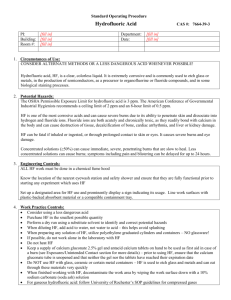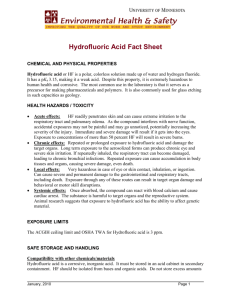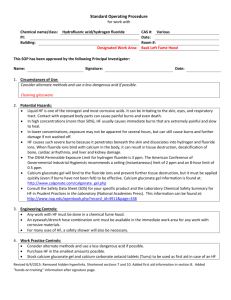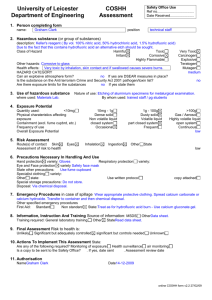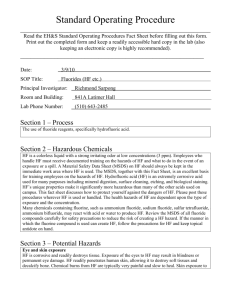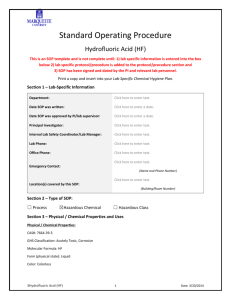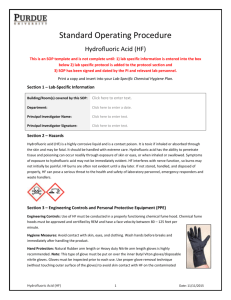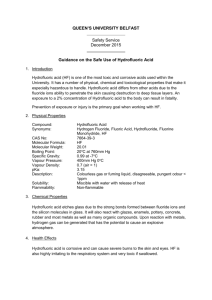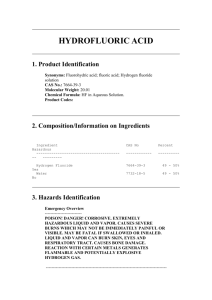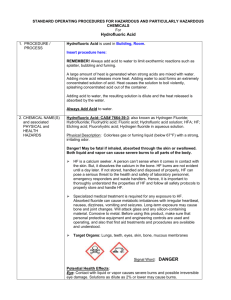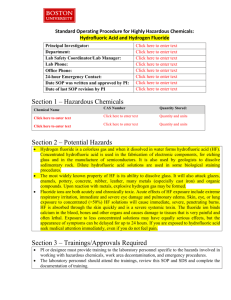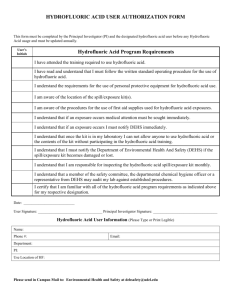Hydrofluoric Acid - OSEH
advertisement
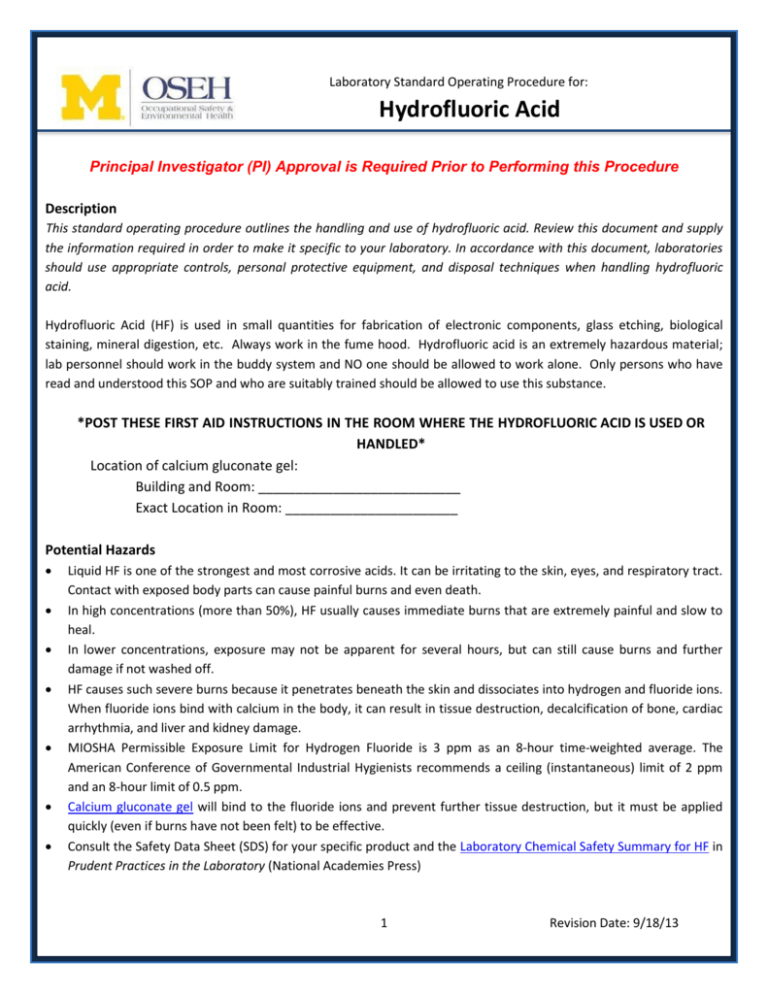
Laboratory Standard Operating Procedure for: Hydrofluoric Acid Principal Investigator (PI) Approval is Required Prior to Performing this Procedure Description This standard operating procedure outlines the handling and use of hydrofluoric acid. Review this document and supply the information required in order to make it specific to your laboratory. In accordance with this document, laboratories should use appropriate controls, personal protective equipment, and disposal techniques when handling hydrofluoric acid. Hydrofluoric Acid (HF) is used in small quantities for fabrication of electronic components, glass etching, biological staining, mineral digestion, etc. Always work in the fume hood. Hydrofluoric acid is an extremely hazardous material; lab personnel should work in the buddy system and NO one should be allowed to work alone. Only persons who have read and understood this SOP and who are suitably trained should be allowed to use this substance. *POST THESE FIRST AID INSTRUCTIONS IN THE ROOM WHERE THE HYDROFLUORIC ACID IS USED OR HANDLED* Location of calcium gluconate gel: Building and Room: ___________________________ Exact Location in Room: _______________________ Potential Hazards Liquid HF is one of the strongest and most corrosive acids. It can be irritating to the skin, eyes, and respiratory tract. Contact with exposed body parts can cause painful burns and even death. In high concentrations (more than 50%), HF usually causes immediate burns that are extremely painful and slow to heal. In lower concentrations, exposure may not be apparent for several hours, but can still cause burns and further damage if not washed off. HF causes such severe burns because it penetrates beneath the skin and dissociates into hydrogen and fluoride ions. When fluoride ions bind with calcium in the body, it can result in tissue destruction, decalcification of bone, cardiac arrhythmia, and liver and kidney damage. MIOSHA Permissible Exposure Limit for Hydrogen Fluoride is 3 ppm as an 8-hour time-weighted average. The American Conference of Governmental Industrial Hygienists recommends a ceiling (instantaneous) limit of 2 ppm and an 8-hour limit of 0.5 ppm. Calcium gluconate gel will bind to the fluoride ions and prevent further tissue destruction, but it must be applied quickly (even if burns have not been felt) to be effective. Consult the Safety Data Sheet (SDS) for your specific product and the Laboratory Chemical Safety Summary for HF in Prudent Practices in the Laboratory (National Academies Press) 1 Revision Date: 9/18/13 Engineering Controls Any work with HF must be done in a chemical fume hood. An eyewash/drench hose combination unit must be available in the immediate work area for any work with corrosive materials. For many uses of HF, an eyewash station and a safety shower will also be necessary. Provide exhaust ventilation or other engineering controls to keep the airborne concentrations of vapors below their respective threshold limit value. Work Practice Controls Consider alternate methods and use a less dangerous acid if possible. Designate areas where HF is stored and manipulated. Purchase HF in the smallest amounts possible. Stock calcium gluconate gel to be used as first aid in case of an HF burn. (Medical attention must still be sought immediately for HF burns.) Prior to using HF, make sure the calcium gluconate tube is unopened and that the gel has not reached the expiration date stamped on the tube. Do not heat hydrofluoric acid. Do not use glass, ceramic, or other incompatible containers for HF. Perform a dry run to identify and correct potential hazards. Add acid to water, not water to acid. Work within sight and/or hearing of at least one other person who is familiar with the hazards and written procedures. Line work surfaces with plastic-backed absorbent paper and/or a containment tray of compatible material. Once work with HF is complete, decontaminate the area by wiping it down with a 10% sodium carbonate (Na2CO3, also known as soda ash) solution. Gaseous hydrogen fluoride: o Follow SOP for compressed gas guideline. o If you have any HF in glass containers, be aware that it can be extremely dangerous. Contact OSEH Hazardous Materials Management (OSEH-HMM) at (734) 763-4568 for an immediate pickup. Personal Protective Equipment Wear a fully-buttoned lab coat with sleeves extended to wrists, face shield AND safety goggles, long cuff neoprene outer gloves and nitrile inner gloves, long pants (or other clothing covering the entire leg), rubber apron, and closed toe shoes. For small amounts of HF (<50 ml), double nitrile gloves can be used but must be changed immediately if splashed or thought to be contaminated. Transportation and Storage Transport corrosives in secondary containment, preferably a polyethylene or other non-reactive acid/solvent bottle carrier. Store in a compatible container (preferably polyethylene). HF reacts with glass, ceramics, and some metals. Place it in a compatible secondary container to capture leaks or spills. Store with other inorganic acids, away from bases and other incompatibles including metal (unless the metal has a corrosion-proof coating), and do not store under the sink. Avoid storing on the floor. Store in a cool, well-ventilated areas. Store below eye level. 2 Store away from incompatibles. Waste Disposal Handle and store HF wastes following the guidelines above while accumulating wastes and awaiting chemical waste pickup. Because most spent, unused and expired chemicals/materials are considered hazardous wastes, they must be properly disposed of. Do not dispose of chemical wastes by dumping them down a sink, flushing in a toilet or discarding in regular trash containers, unless authorized by OSEH Hazardous Materials Management (HMM). Contact OSEH-HMM at (734) 763-4568 for waste containers, labels, manifests, waste collection and for any questions regarding proper waste disposal. Also refer to OSEH’s Hazardous Waste webpage for more information. Exposures/Unintended contact If the employee is in need of emergency medical attention, call 911 immediately For an actual chemical exposure/injury: In case of SKIN exposure, remove contaminated clothing from affected area. Rinse with water for 5 minutes. Immediately after rinsing, use a gloved hand to apply calcium gluconate gel to the skin and rub it in. Seek medical treatment below. In case of EYE exposure, flush eyes with water for 15 minutes. Hold the eyelids open and away from the eye to allow thorough flushing. Seek medical treatment below. Ice water compresses may be applied to eyes while transporting the person to the doctor. For situations with risk of inhalation exposure (including spills of powder outside of a chemical fume hood), remove all persons from the contaminated area and contact OSEH-HMM (734) 763-4568. If an ambulance is needed, call the University of Michigan Police Department (UMPD) at 911 to request assistance. Contact OSEH for advice on symptoms of chemical exposure, or assistance in performing an exposure assessment. Report all work related accidents, injuries, illnesses or exposures to WorkConnections within 24 hours by completing and submitting the Illness and Injury Report Form. Follow the directions on the WorkConnections website Forms Instructions to obtain proper medical treatment and follow-up. Complete the OSEH Laboratory Incident and Near-Miss Report form. TREATMENT FACILITIES: U-M Occupational Health Services -- Campus Employees Mon-Fri 7:30 am - 4:30 pm After hours - go to UM Hospital Emergency Dept. – Urgent Care Clinic C380 Med Inn building 1500 East Medical Center Drive, Ann Arbor (734) 764-8021 3 University Health Services -- University students (non-life threatening conditions) Mon-Fri 8 am – 4:30 pm, Sat 9 am – 12 pm Contact for current hours as they may vary 207 Fletcher Street, Ann Arbor (734) 764-8320 UMHS Emergency Department -- after clinic hours or on weekends 1500 East Medical Center Drive, Ann Arbor, (734) 936-6666 Click here for additional accident and injury reporting information. Spill Procedure When a spill occurs, personal safety should always come first. Alert and clear everyone in the immediate area where the spill occurred. On the UM campus, any spill of more than 5 ml of hydrofluoric acid must be referred to OSEH-HMM by calling (734) 763-4568 from any phone. Spills of HF in the fume hood (<5 ml) can be absorbed using magnesium sulfate, soda lime, sodium carbonate (Na2CO3), or other spill absorbent specified for HF. Do NOT use organic spill kits that contain Floor-Dri, kitty litter, or sand because HF reacts with silica to produce silicon tetrafluoride (a toxic gas). After spill has been completely absorbed, wipe down spill site with 10% sodium carbonate solution. If any large Hydrofluoric Acid solution is spilled, leave the lab and call UMPD at 911 to request assistance from OSEH. Do not take any action to cover the spill. Post a warning on the lab and do not allow others to enter. Have a person available that has knowledge of the incident and laboratory to assist emergency personnel. Additional Spill Links: www.oseh.umich.edu/pdf/chemspil.pdf http://www.oseh.umich.edu/emer-chemical.shtml. Report all emergencies, suspicious activity, injuries, spills, and fires to the University of Michigan Division of Public Safety and Security (DPSS) by calling 911 or texting 377911. Register with the University of Michigan Emergency Alert System via Wolverine Access. Training of Personnel All personnel are required to complete the General Laboratory Safety Training session (BLS025w or equivalent) via OSEH’s My LINC website. Furthermore, all personnel shall read and fully adhere to this SOP when handling hydrofluoric acid. Certification I have read and understand the above SOP. I agree to contact my Supervisor or Lab manager if I plan to modify this procedure. Name Signature UM ID # 4 Date Principal Investigator Revision Date 5
